PONTIAC VIBE 2007 Owners Manual
Manufacturer: PONTIAC, Model Year: 2007, Model line: VIBE, Model: PONTIAC VIBE 2007Pages: 432, PDF Size: 2.54 MB
Page 101 of 432
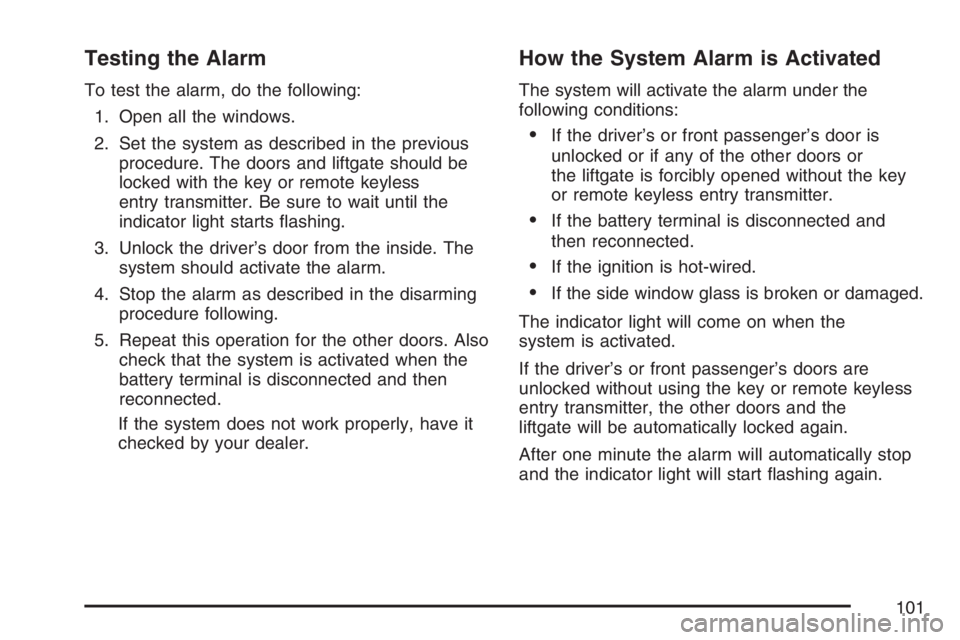
Testing the Alarm
To test the alarm, do the following:
1. Open all the windows.
2. Set the system as described in the previous
procedure. The doors and liftgate should be
locked with the key or remote keyless
entry transmitter. Be sure to wait until the
indicator light starts �ashing.
3. Unlock the driver’s door from the inside. The
system should activate the alarm.
4. Stop the alarm as described in the disarming
procedure following.
5. Repeat this operation for the other doors. Also
check that the system is activated when the
battery terminal is disconnected and then
reconnected.
If the system does not work properly, have it
checked by your dealer.
How the System Alarm is Activated
The system will activate the alarm under the
following conditions:
If the driver’s or front passenger’s door is
unlocked or if any of the other doors or
the liftgate is forcibly opened without the key
or remote keyless entry transmitter.
If the battery terminal is disconnected and
then reconnected.
If the ignition is hot-wired.
If the side window glass is broken or damaged.
The indicator light will come on when the
system is activated.
If the driver’s or front passenger’s doors are
unlocked without using the key or remote keyless
entry transmitter, the other doors and the
liftgate will be automatically locked again.
After one minute the alarm will automatically stop
and the indicator light will start �ashing again.
101
Page 102 of 432
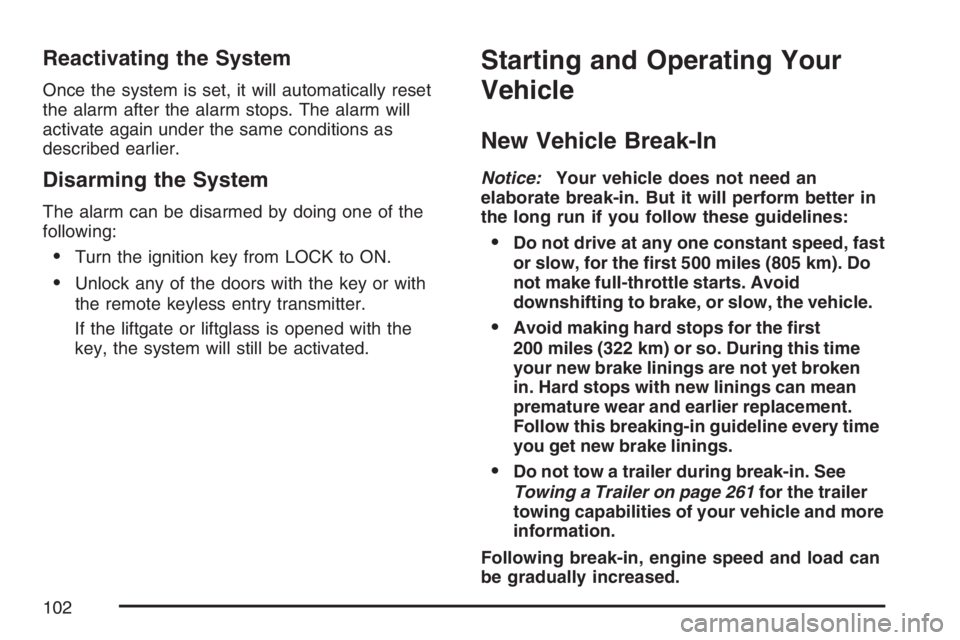
Reactivating the System
Once the system is set, it will automatically reset
the alarm after the alarm stops. The alarm will
activate again under the same conditions as
described earlier.
Disarming the System
The alarm can be disarmed by doing one of the
following:
Turn the ignition key from LOCK to ON.
Unlock any of the doors with the key or with
the remote keyless entry transmitter.
If the liftgate or liftglass is opened with the
key, the system will still be activated.
Starting and Operating Your
Vehicle
New Vehicle Break-In
Notice:Your vehicle does not need an
elaborate break-in. But it will perform better in
the long run if you follow these guidelines:
Do not drive at any one constant speed, fast
or slow, for the �rst 500 miles (805 km). Do
not make full-throttle starts. Avoid
downshifting to brake, or slow, the vehicle.
Avoid making hard stops for the �rst
200 miles (322 km) or so. During this time
your new brake linings are not yet broken
in. Hard stops with new linings can mean
premature wear and earlier replacement.
Follow this breaking-in guideline every time
you get new brake linings.
Do not tow a trailer during break-in. See
Towing a Trailer on page 261for the trailer
towing capabilities of your vehicle and more
information.
Following break-in, engine speed and load can
be gradually increased.
102
Page 103 of 432
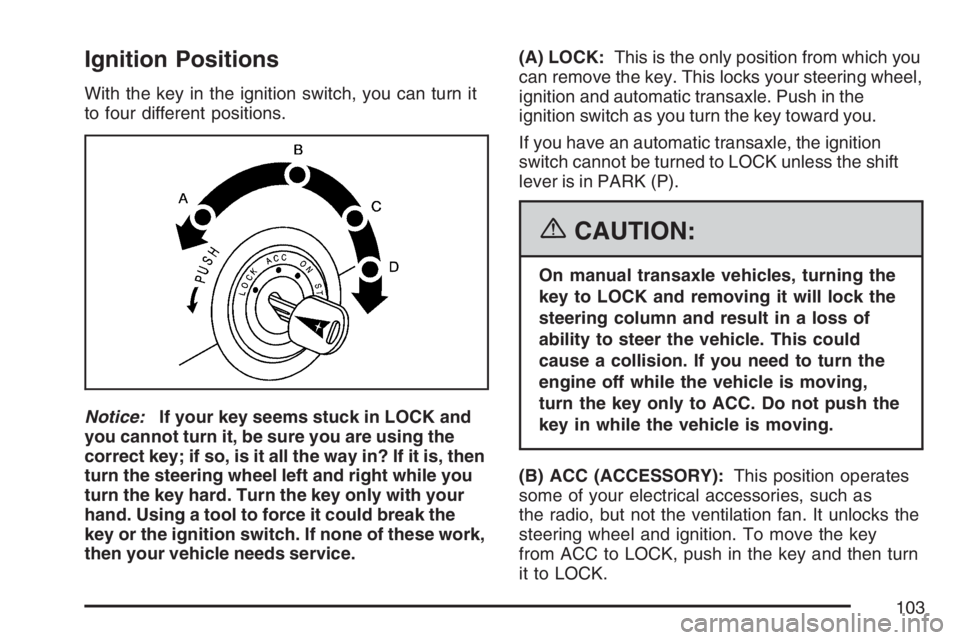
Ignition Positions
With the key in the ignition switch, you can turn it
to four different positions.
Notice:If your key seems stuck in LOCK and
you cannot turn it, be sure you are using the
correct key; if so, is it all the way in? If it is, then
turn the steering wheel left and right while you
turn the key hard. Turn the key only with your
hand. Using a tool to force it could break the
key or the ignition switch. If none of these work,
then your vehicle needs service.(A) LOCK:This is the only position from which you
can remove the key. This locks your steering wheel,
ignition and automatic transaxle. Push in the
ignition switch as you turn the key toward you.
If you have an automatic transaxle, the ignition
switch cannot be turned to LOCK unless the shift
lever is in PARK (P).
{CAUTION:
On manual transaxle vehicles, turning the
key to LOCK and removing it will lock the
steering column and result in a loss of
ability to steer the vehicle. This could
cause a collision. If you need to turn the
engine off while the vehicle is moving,
turn the key only to ACC. Do not push the
key in while the vehicle is moving.
(B) ACC (ACCESSORY):This position operates
some of your electrical accessories, such as
the radio, but not the ventilation fan. It unlocks the
steering wheel and ignition. To move the key
from ACC to LOCK, push in the key and then turn
it to LOCK.
103
Page 104 of 432
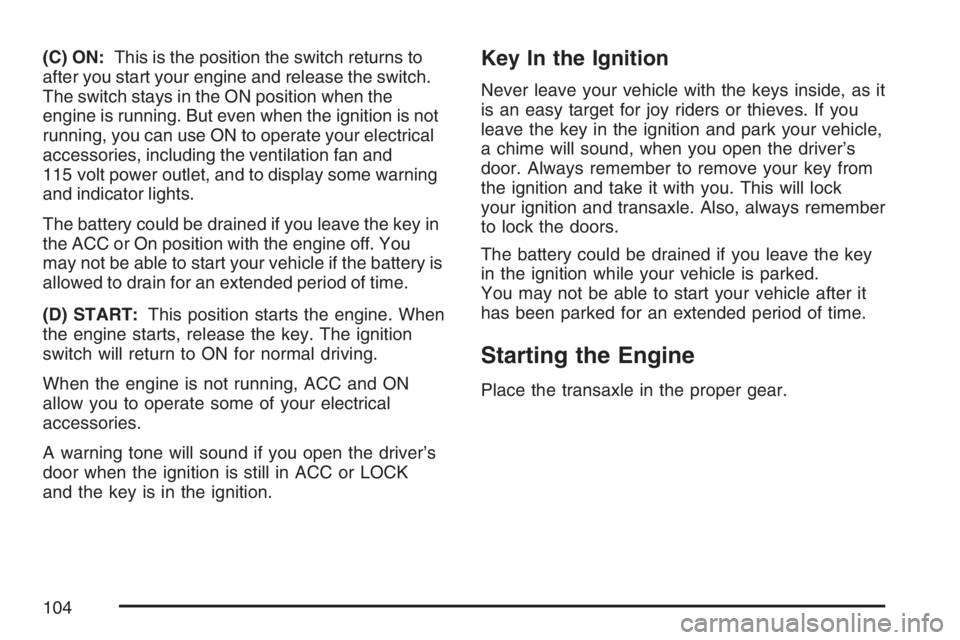
(C) ON:This is the position the switch returns to
after you start your engine and release the switch.
The switch stays in the ON position when the
engine is running. But even when the ignition is not
running, you can use ON to operate your electrical
accessories, including the ventilation fan and
115 volt power outlet, and to display some warning
and indicator lights.
The battery could be drained if you leave the key in
the ACC or On position with the engine off. You
may not be able to start your vehicle if the battery is
allowed to drain for an extended period of time.
(D) START:This position starts the engine. When
the engine starts, release the key. The ignition
switch will return to ON for normal driving.
When the engine is not running, ACC and ON
allow you to operate some of your electrical
accessories.
A warning tone will sound if you open the driver’s
door when the ignition is still in ACC or LOCK
and the key is in the ignition.Key In the Ignition
Never leave your vehicle with the keys inside, as it
is an easy target for joy riders or thieves. If you
leave the key in the ignition and park your vehicle,
a chime will sound, when you open the driver’s
door. Always remember to remove your key from
the ignition and take it with you. This will lock
your ignition and transaxle. Also, always remember
to lock the doors.
The battery could be drained if you leave the key
in the ignition while your vehicle is parked.
You may not be able to start your vehicle after it
has been parked for an extended period of time.
Starting the Engine
Place the transaxle in the proper gear.
104
Page 105 of 432
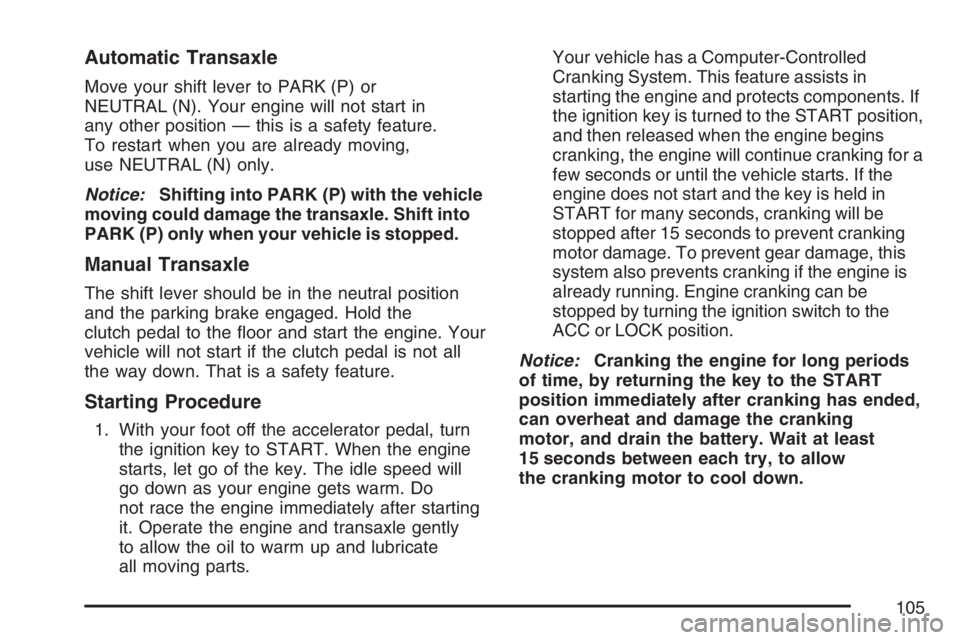
Automatic Transaxle
Move your shift lever to PARK (P) or
NEUTRAL (N). Your engine will not start in
any other position — this is a safety feature.
To restart when you are already moving,
use NEUTRAL (N) only.
Notice:Shifting into PARK (P) with the vehicle
moving could damage the transaxle. Shift into
PARK (P) only when your vehicle is stopped.
Manual Transaxle
The shift lever should be in the neutral position
and the parking brake engaged. Hold the
clutch pedal to the �oor and start the engine. Your
vehicle will not start if the clutch pedal is not all
the way down. That is a safety feature.
Starting Procedure
1. With your foot off the accelerator pedal, turn
the ignition key to START. When the engine
starts, let go of the key. The idle speed will
go down as your engine gets warm. Do
not race the engine immediately after starting
it. Operate the engine and transaxle gently
to allow the oil to warm up and lubricate
all moving parts.Your vehicle has a Computer-Controlled
Cranking System. This feature assists in
starting the engine and protects components. If
the ignition key is turned to the START position,
and then released when the engine begins
cranking, the engine will continue cranking for a
few seconds or until the vehicle starts. If the
engine does not start and the key is held in
START for many seconds, cranking will be
stopped after 15 seconds to prevent cranking
motor damage. To prevent gear damage, this
system also prevents cranking if the engine is
already running. Engine cranking can be
stopped by turning the ignition switch to the
ACC or LOCK position.
Notice:Cranking the engine for long periods
of time, by returning the key to the START
position immediately after cranking has ended,
can overheat and damage the cranking
motor, and drain the battery. Wait at least
15 seconds between each try, to allow
the cranking motor to cool down.
105
Page 106 of 432
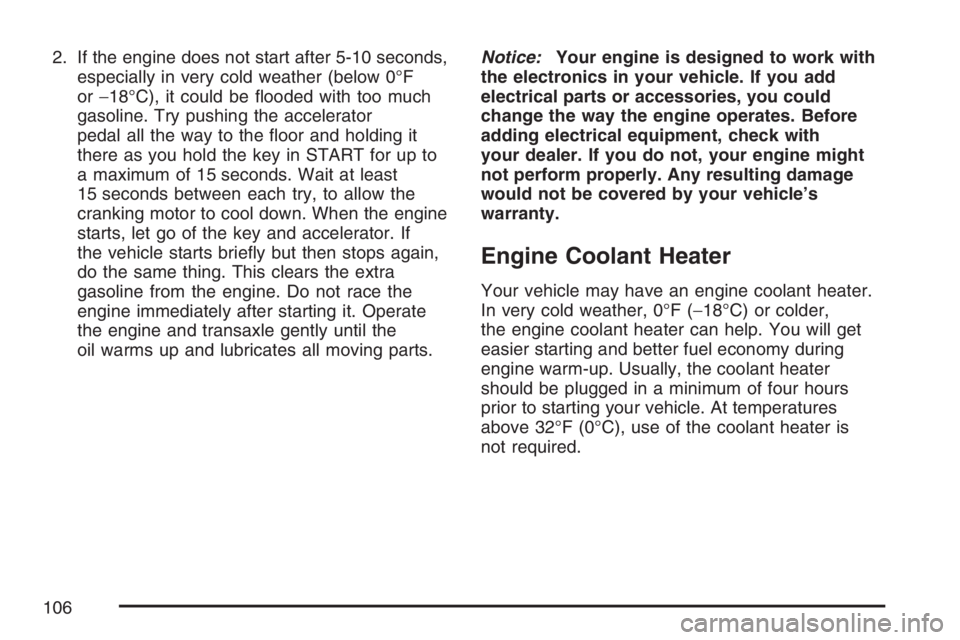
2. If the engine does not start after 5-10 seconds,
especially in very cold weather (below 0°F
or−18°C), it could be �ooded with too much
gasoline. Try pushing the accelerator
pedal all the way to the �oor and holding it
there as you hold the key in START for up to
a maximum of 15 seconds. Wait at least
15 seconds between each try, to allow the
cranking motor to cool down. When the engine
starts, let go of the key and accelerator. If
the vehicle starts brie�y but then stops again,
do the same thing. This clears the extra
gasoline from the engine. Do not race the
engine immediately after starting it. Operate
the engine and transaxle gently until the
oil warms up and lubricates all moving parts.Notice:Your engine is designed to work with
the electronics in your vehicle. If you add
electrical parts or accessories, you could
change the way the engine operates. Before
adding electrical equipment, check with
your dealer. If you do not, your engine might
not perform properly. Any resulting damage
would not be covered by your vehicle’s
warranty.
Engine Coolant Heater
Your vehicle may have an engine coolant heater.
In very cold weather, 0°F (−18°C) or colder,
the engine coolant heater can help. You will get
easier starting and better fuel economy during
engine warm-up. Usually, the coolant heater
should be plugged in a minimum of four hours
prior to starting your vehicle. At temperatures
above 32°F (0°C), use of the coolant heater is
not required.
106
Page 107 of 432
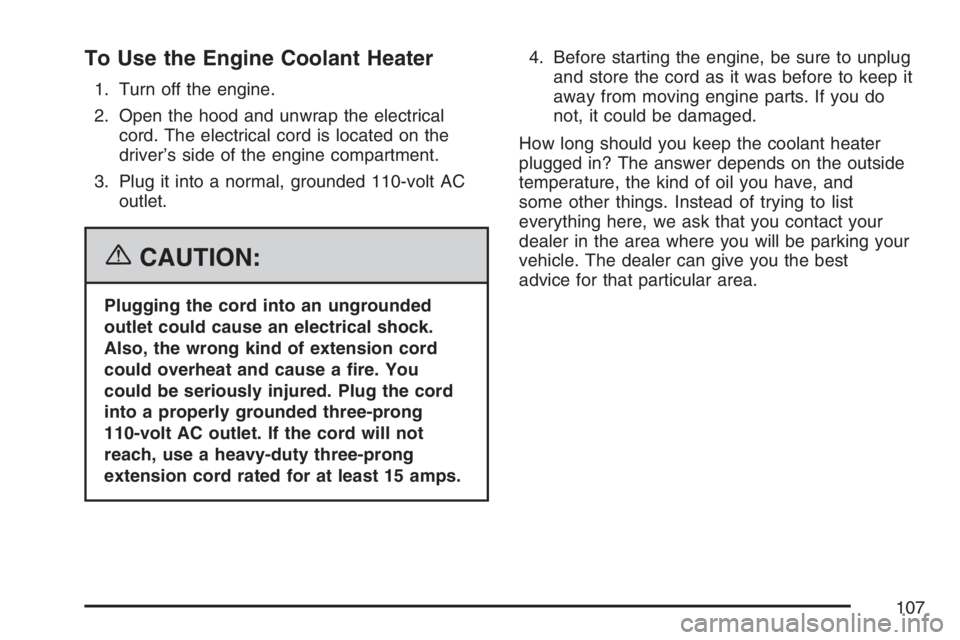
To Use the Engine Coolant Heater
1. Turn off the engine.
2. Open the hood and unwrap the electrical
cord. The electrical cord is located on the
driver’s side of the engine compartment.
3. Plug it into a normal, grounded 110-volt AC
outlet.
{CAUTION:
Plugging the cord into an ungrounded
outlet could cause an electrical shock.
Also, the wrong kind of extension cord
could overheat and cause a �re. You
could be seriously injured. Plug the cord
into a properly grounded three-prong
110-volt AC outlet. If the cord will not
reach, use a heavy-duty three-prong
extension cord rated for at least 15 amps.4. Before starting the engine, be sure to unplug
and store the cord as it was before to keep it
away from moving engine parts. If you do
not, it could be damaged.
How long should you keep the coolant heater
plugged in? The answer depends on the outside
temperature, the kind of oil you have, and
some other things. Instead of trying to list
everything here, we ask that you contact your
dealer in the area where you will be parking your
vehicle. The dealer can give you the best
advice for that particular area.
107
Page 108 of 432

Automatic Transaxle Operation
There are several
different positions for
your shift lever.
PARK (P):This position locks your front wheels. It
is the best position to use when you start your
engine because your vehicle cannot move easily.
{CAUTION:
It is dangerous to get out of your vehicle
if the shift lever is not fully in PARK (P)
with the parking brake �rmly set. Your
vehicle can roll.
CAUTION: (Continued)
CAUTION: (Continued)
Do not leave your vehicle when the engine
is running unless you have to. If you have
left the engine running, the vehicle can
move suddenly. You or others could be
injured. To be sure your vehicle will not
move, even when you are on fairly level
ground, always set your parking brake
and move the shift lever to PARK (P). See
Shifting Into Park (P) (Automatic
Transaxle) on page 115. If you are pulling
a trailer, seeTowing a Trailer on page 261.
Make sure that the shift lever is fully in PARK (P)
before starting the engine.
108
Page 109 of 432
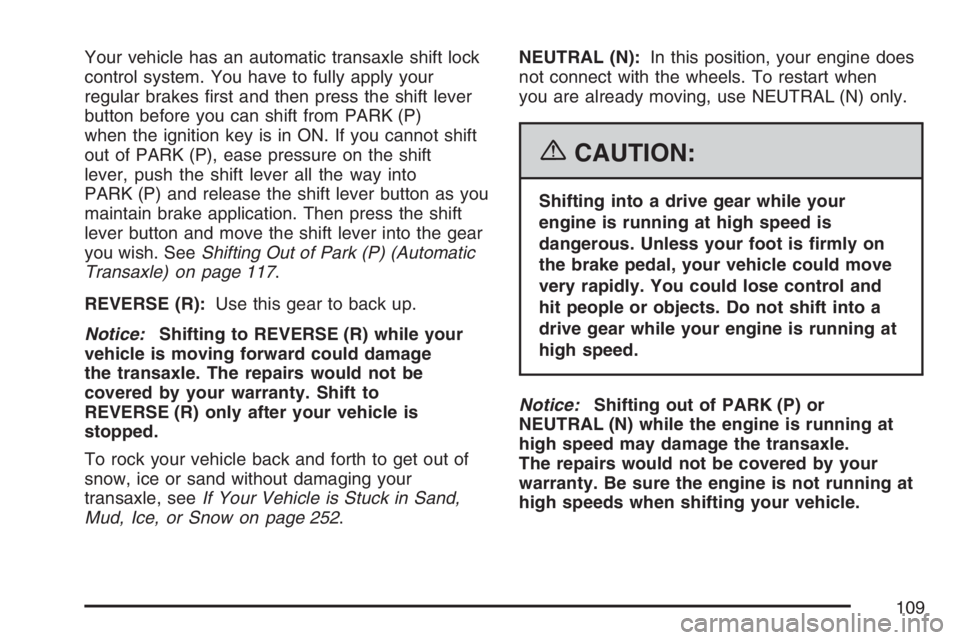
Your vehicle has an automatic transaxle shift lock
control system. You have to fully apply your
regular brakes �rst and then press the shift lever
button before you can shift from PARK (P)
when the ignition key is in ON. If you cannot shift
out of PARK (P), ease pressure on the shift
lever, push the shift lever all the way into
PARK (P) and release the shift lever button as you
maintain brake application. Then press the shift
lever button and move the shift lever into the gear
you wish. SeeShifting Out of Park (P) (Automatic
Transaxle) on page 117.
REVERSE (R):Use this gear to back up.
Notice:Shifting to REVERSE (R) while your
vehicle is moving forward could damage
the transaxle. The repairs would not be
covered by your warranty. Shift to
REVERSE (R) only after your vehicle is
stopped.
To rock your vehicle back and forth to get out of
snow, ice or sand without damaging your
transaxle, seeIf Your Vehicle is Stuck in Sand,
Mud, Ice, or Snow on page 252.NEUTRAL (N):In this position, your engine does
not connect with the wheels. To restart when
you are already moving, use NEUTRAL (N) only.
{CAUTION:
Shifting into a drive gear while your
engine is running at high speed is
dangerous. Unless your foot is �rmly on
the brake pedal, your vehicle could move
very rapidly. You could lose control and
hit people or objects. Do not shift into a
drive gear while your engine is running at
high speed.
Notice:Shifting out of PARK (P) or
NEUTRAL (N) while the engine is running at
high speed may damage the transaxle.
The repairs would not be covered by your
warranty. Be sure the engine is not running at
high speeds when shifting your vehicle.
109
Page 110 of 432
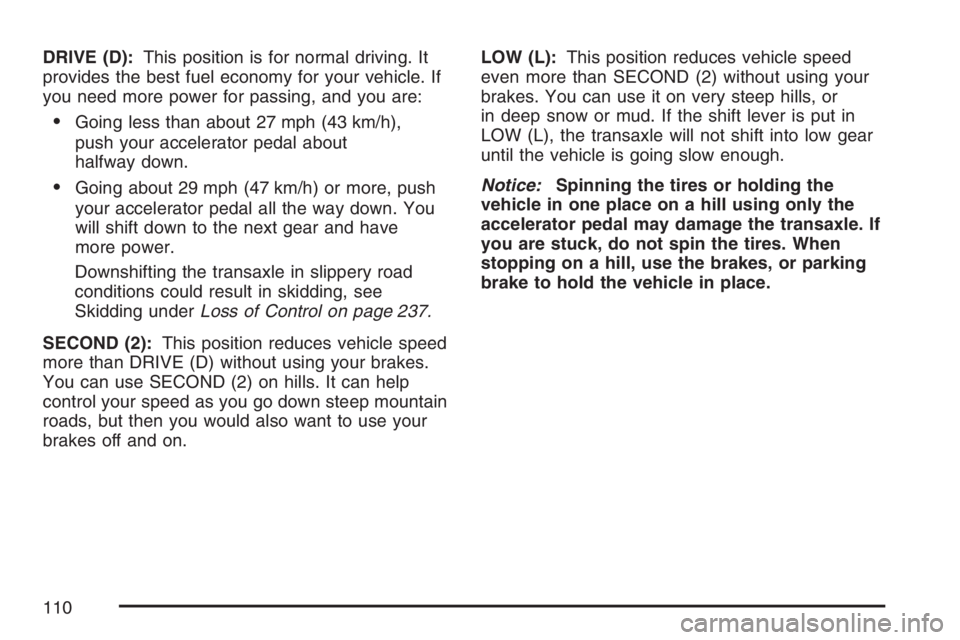
DRIVE (D):This position is for normal driving. It
provides the best fuel economy for your vehicle. If
you need more power for passing, and you are:
Going less than about 27 mph (43 km/h),
push your accelerator pedal about
halfway down.
Going about 29 mph (47 km/h) or more, push
your accelerator pedal all the way down. You
will shift down to the next gear and have
more power.
Downshifting the transaxle in slippery road
conditions could result in skidding, see
Skidding underLoss of Control on page 237.
SECOND (2):This position reduces vehicle speed
more than DRIVE (D) without using your brakes.
You can use SECOND (2) on hills. It can help
control your speed as you go down steep mountain
roads, but then you would also want to use your
brakes off and on.LOW (L):This position reduces vehicle speed
even more than SECOND (2) without using your
brakes. You can use it on very steep hills, or
in deep snow or mud. If the shift lever is put in
LOW (L), the transaxle will not shift into low gear
until the vehicle is going slow enough.
Notice:Spinning the tires or holding the
vehicle in one place on a hill using only the
accelerator pedal may damage the transaxle. If
you are stuck, do not spin the tires. When
stopping on a hill, use the brakes, or parking
brake to hold the vehicle in place.
110